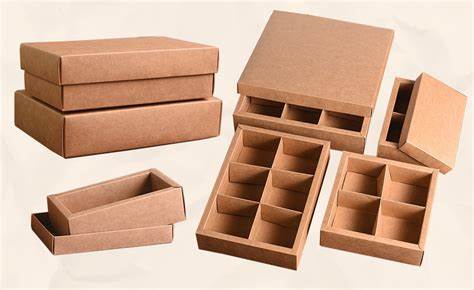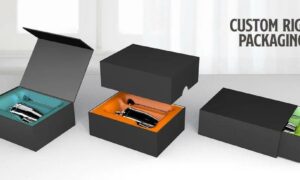Introduction
Telescoping rigid boxes are a popular packaging option that consists of two pieces that fit together to create a snug and secure container. They are commonly used for packaging delicate and valuable items such as electronic devices, glassware, and artwork. However, not all telescoping boxes are created equal, and sometimes, a standard size or style may not meet the specific needs of a business or individual.
This is where customization comes in. Customizing telescoping rigid boxes allows businesses and individuals to create a container that meets their specifications. This can include altering the size, shape, and material used to create the box. Customization can also involve branding the box with a company logo or specific color scheme, creating a unique and recognizable packaging option.
Structure
Telescoping rigid boxes are versatile packaging solutions that offer excellent protection to their contents during transportation and storage. They consist of two separate pieces, a lid, and a tray, that fit together to create a solid and sturdy box. The telescoping design of the box allows for easy and secure stacking, making it a popular choice for industries such as e-commerce, pharmaceuticals, and food and beverage.
Customizable Features of Telescoping rigid Boxes
i. Size
The size of a custom telescoping rigid box is one of the essential customizable features. The dimensions of the box can be tailored to fit the exact specifications of the product it is meant to contain. This is particularly important for fragile and delicate items that require a snug fit to prevent movement during transportation.
Customizing the size of the telescoping rigid boxes can also reduce material waste and transportation costs. A box that is too big for the product will require additional packaging materials to fill the space, while a box that is too small will not provide adequate protection.
ii. Material
Custom Telescoping rigid boxes can be made from various materials, including corrugated cardboard, and paperboard. The choice of material will depend on factors such as the weight and fragility of the product, as well as the desired level of protection and durability. Corrugated cardboard is popular for telescoping boxes due to its strength and versatility. It can be customized to various thicknesses and printed with high-quality graphics to enhance branding. Paperboard is another option for lightweight products, and it can be coated with various finishes to create a premium look and feel.
iii. Printing
Printing is an essential aspect of customizing telescoping rigid boxes, as it can help to enhance branding and increase product visibility. Companies can print their logos, product information, and branding messages directly onto the boxes to create a unique and memorable packaging experience for their customers.
High-quality printing can also improve the aesthetics of the box, making it more attractive and visually appealing. This can help increase the product’s perceived value and encourage repeat purchases.
iv. Color
The color of a telescoping rigid boxes can also be customized to suit individual needs. Companies can choose from various colors to match their branding and create a cohesive packaging experience. They can also use bold and vibrant colors to make their products stand out on store shelves.
v. Embossing and Foil Stamping
Embossing and foil stamping are two customization options that can add a premium touch to telescoping boxes. Embossing involves creating a raised design on the box’s surface, while foil stamping involves applying a metallic or colored foil to the surface.
These customization options help create a unique and memorable packaging experience for customers. They can be used to highlight important information, such as the product name or company logo, or to add decorative elements to the box.
vi. Die-Cutting
Die-cutting is a customization option that involves cutting a specific shape or design into the box’s surface. This can create unique and eye-catching packaging designs that stand out from traditional rectangular boxes.
Die-cutting can also be used to create functional elements such as handles or windows, which can improve the usability of the box and make it easier for customers.
Advantages:
- One of the main advantages of customizing telescoping rigid boxesis the ability to create a packaging solution that fits the product perfectly. This helps to reduce the risk of damage during transportation and storage, ultimately leading to cost savings and a better customer experience. Customization also allows businesses to stand out in a crowded market by creating a unique and memorable packaging option that reinforces their brand identity.
- Customizing telescoping boxes can offer several benefits, such as better protection, increased branding, and improved functionality.
- Customizing telescoping boxes can be a valuable investment for businesses and individuals looking to create a packaging solution that meets their needs. By creating a unique and secure container that fits their product perfectly, they can improve the customer experience.
- Customizing telescoping boxes typically involves working with a packaging supplier or manufacturer. The supplier will work with the business or individual to determine their specific needs and create a design that meets those requirements. The design will then be sent to the manufacturer for production, and the finished product will be shipped to the customer.
Conclusion
Customizing telescoping rigid boxes can be a great way to enhance your product’s packaging and brand image. These boxes are made up of two pieces, a lid, and a base, that can be easily adjusted to fit the size and shape of your product. There are several factors to consider when customizing telescoping rigid boxes, including size, materials, printing, and additional features. In this conclusion, we will summarize some key points to remember when customizing telescoping boxes.
- When customizing telescoping rigid boxes, the box size should be carefully considered. The box should be large enough to accommodate the product and any additional packaging materials but not so large that the product is loose inside the box. Customizing the size of the box also allows for efficient use of storage and shipping space, which can save money in the long run.
- The materials used to create a telescoping rigid boxes can vary depending on the product being packaged and the desired level of protection. Common materials include cardboard, corrugated and cardboard. The thickness of the material can also be adjusted to provide more or less protection. Customizing the materials can provide a more luxurious feel or create a more eco-friendly packaging option.
- Customizing the printing on a telescoping rigid boxes helps elevate the brand image and make the packaging more eye-catching. The printing can include brand logos, product information, or other design elements that help to differentiate the product from competitors. Consider using high-quality printing techniques like digital printing to ensure a professional look.
- Customizing telescoping rigid boxes with additional features can make the packaging more functional and attractive. Some additional standard features include windows or cutouts to showcase the product inside, handles for easy carrying, or inserts to hold the product securely in place. These additional features can also give the customer a more memorable unboxing experience.
- Customizing telescoping rigid boxes can provide several benefits for businesses looking to enhance their packaging and brand image. By carefully considering the size, materials, printing, and additional features, businesses can create a unique and functional packaging solution that sets their product apart. Telescoping rigid boxes can also provide a cost-effective and eco-friendly option for packaging, making them a versatile solution for a wide range of products.



































